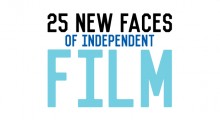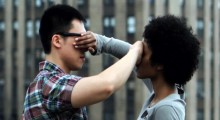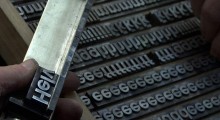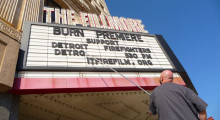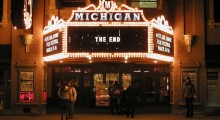Filmmaking
Filmmaking
-
25 New Faces of Film 2014

Click here to see Filmmaker‘s 25 New Faces of Film 2014.
-
“It’s Just a General”: How to Take a General Meeting

At some point in your career, things are going to break your way — you’ll be lucky enough to have your crowdfunded labor of love generate some heat at a big festival. Or your short film will go viral. Or maybe you’ll sell a hot spec or make the Black List. Whatever happens, you’ll land managers and agents, and people in L.A. will want to meet you — and not a minute too soon, because you’re four months behind on rent and need to pay for T-shirts for all your backers. It’s time to meet studio execs looking to hire […]
-
Super 8

1 Blockchain If a group of computer scientists and financial technicians are right, the mysterious Satoshi Nakamoto’s most-celebrated creation may not be a peer-to-peer technology that lets you buy online contraband — Bitcoin — but rather its underlying invention. The blockchain is a shared transaction database that permits verification without a centralized authority, and VC funds such as Union Square Ventures are already predicting the computer science breakthrough will revolutionize everything from banking to voting to the law. 2 You Won’t Remember Dying Recorded in a single day in 1971, this under-known deep cut from the psych-rock vaults was the […]
-
Note This! How to Successfully — and Thankfully — Receive Notes on Your Film or Screenplay

“I would write a book, or a short story, at least three times — once to understand it, the second time to improve the prose, and a third to compel it to say what it still must say.” – Bernard Malamud “Relax and take notes, while I take tokes.” – Notorious B.I.G. I was once at a work-in-progress screening of an independent film for which we were asked to give notes. It was a long cut, and we’d all come out in the rain. After the screening, the director sat by himself near us. When someone addressed him directly, he […]
-
Tall Enough and The Short Films of Barry Jenkins

In an article by Esther Robinson in our upcoming Summer issue, Barry Jenkins speaks to the delicate work-work balance incurred by many a filmmaker — that is to say, what he does to financially support his filmmaking career, and how that job tends to detract from passion projects. Jenkins is fortunate enough that his particular day job, as ringleader of the production company Strike Anywhere, allows him to regularly create content, even if of the branded and not feature-length variety. Over at Fandor, resident video essayist Kevin Lee takes a look at Strike Anywhere’s catalogue, and the work Jenkins has produced in the six […]
-
Marc Schiller Talks the Benefits of Movie Bundling

This week Bond/360 launched what they’ve dubbed a “Creativity Bundle” — four movies having to do with making and creation downloadable from VHX for a single, pay-what-you-wish fee. In a blog post I wrote about Bond/360’s use of what’s become known as “the Radiohead model,” based on the recording group’s pricing strategy for their In Rainbows album. But there’s another innovation going on here, and that’s the bundling of titles. Film packages are a staple of foreign sales, but usually they work in a different way. A distributor must buy a package of films in order to get the one […]
-
Nine Lessons for Self-Distributing Filmmakers with No Money and No Experience

This article by Tom Putnam and Brenna Sanchez about the distribution of their Detroit firefighter documentary Burn originally appeared in our Fall, 2013 print edition. It is appearing online for the first time. “The reports of my death are greatly exaggerated.” — Mark Twain As filmgoers are increasingly flooded with new media options to keep them at home, the prevailing theory is that the days of theatrical releases for independent films are in their last slow throes. We disagree because we just spent the last year filling 300- to 2,000-seat theaters in 170 cities with our firefighter documentary Burn. We […]
-
Platform Monopolies: Good or Bad for Independent Filmmakers?

Dubbed “a novelist from the day after tomorrow” in Sunday’s New York Times, Vincent Zandri profits, quite well, by living in the Amazon universe. His mystery novels are edited, published, marketed and sold by Amazon. Perhaps most importantly, the mechanism through which new readers will discover his work, the latticework of likes, referrals and recommendations, are increasingly controlled by Amazon and its related properties, like Goodreads. For Zandri, who achieved modest success through traditional publishers before signing with Amazon’s Thomas & Mercer imprint, the internet giant’s model is the new way. Reduced to “returning bottles and cans for grocery money,” […]
-
Bond/360 Launches “Pay What You Wish” Four-Movie “Creativity Bundle”

Hailed as revolutionary back in 2007, “the Radiohead model” — pay-what-you-wish downloadable media pricing — never flourished in the years following. Even Radiohead abandoned it. Yet, as Bond/360 is setting out to prove, it may still have its place when it comes to independent film. Tonight at midnight they’re launching a four-film “Creativity Bundle” download through VHX. Pay what you want to own — not rent — four movies. And, just as Radiohead’s In Rainbows was one of their best, these titles (or at least the two I’ve seen) are excellent: Indie Game, Helvetica, Sign Painters and Beauty is Embarrassing. […]
-
Distribution Strategies for the Regional Festival Circuit

A little while back, I looked at a small portion of The Film Collaborative’s most recent book, Selling Your Film Outside the US, which considered an unusual case of DIY distribution in Europe. Now, over at their blog, Sheri Candler and Orly Ravid are running a series on distribution preparation for filmmakers worldwide. As submissions for Sundance are already open, the latest entry centers on festivals, and why you should already have a distribution strategy on the back burner before your acceptance, or, rejection. If you don’t get into one of the top-tier festivals (Sundance, Berlin, Toronto, etc.), teeming with reluctant buyers, the chances that your film will […]
